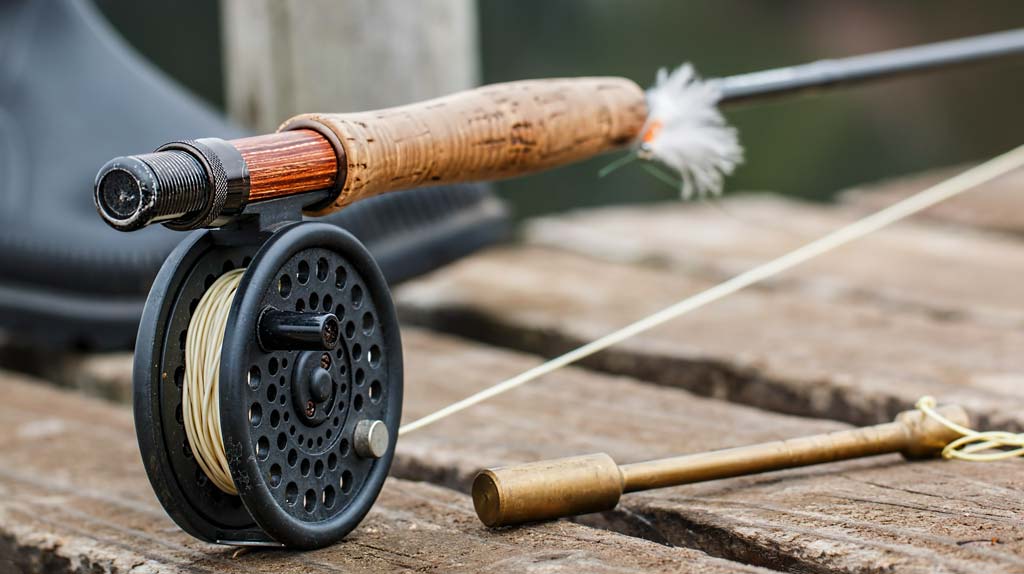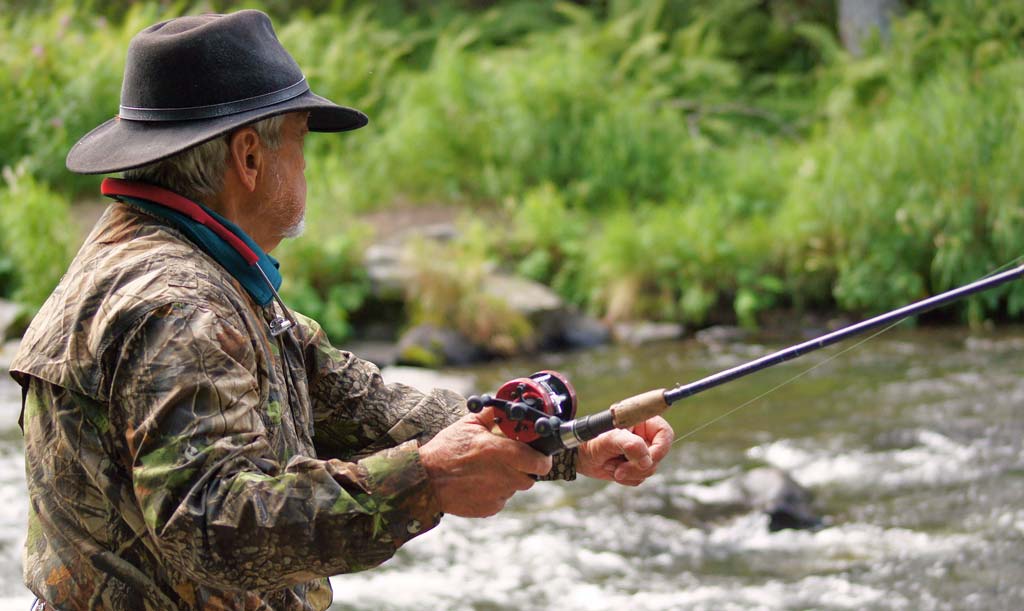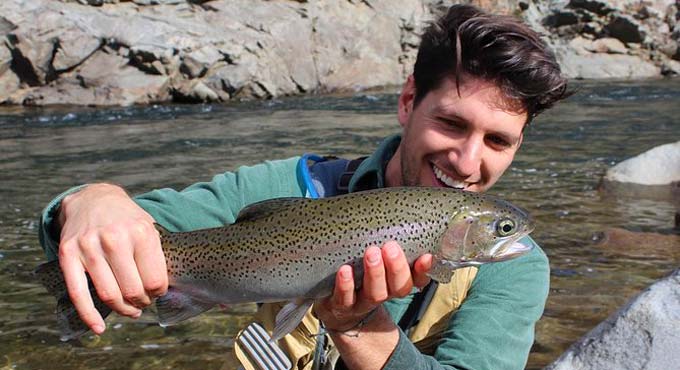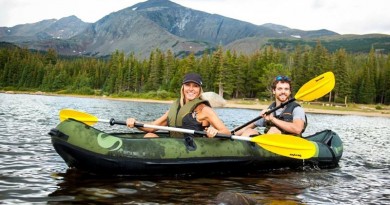Yosemite Fly Fishing: When the Creek Calls, Answer
There is nothing as exhilarating and yet calming as a day of fly-fishing in Yosemite National Park. At least that’s what a buddy of mine told me over a morning cup of campfire coffee. He proceeded to share his Yosemite adventure as the glowing embers left over from last night’s fire danced like fireflies in the morning dew.
He took a sip from his red tin mug with a chipped lip, looked into the distance above my head like he was stepping back in time, and said:
A babbling brook bounds down the steep terrain of Yosemite Valley’s Rush Creek Lodge. You simply cannot ignore its presence. Its soothing voice follows you at every turn on the property.
That brook is a reminder, a natural voice, and a symbol of Yosemite National Park’s spirit of personal exploration in an unspoiled mountain setting. The creek remains pristine, just like the days of old when thousands of eager gold prospectors came to the area in search of fortune. It’s as if the creek shouts: “Go Out, Explore! Take a chance. The treasures of the world await.”
It’s a voice hard to ignore.

Picking The Best Yosemite Fly-Fishing Guide Makes All The Difference
Listening to the voice, I took its advice and scheduled a morning of fly-fishing. Up until this point, my fishing adventures had been limited to an outing in a leaking inflatable fishing kayak as a young boy. Never having been fly-fishing before, I was a bit wary, but expert guide, Bryant Burnette, led me step by step in a gentle education about the world that is fly-fishing.
A world I knew existed, but the depth of which I had no idea. The tranquil image of anglers standing out in a rushing stream or river ran through my head like the mantra in zen meditation. I pictured myself doing the same. A moment of calm, peace, a break from the bustle of life.
Bryant is just one of the expert guides that Rush Creek Lodge seems to have at the call of a phone to host experienced and novice anglers. He introduced me to the basics. I was a bit intimidated at first, but his easygoing manner gave me the confidence I needed to keep everything straight in my head.
First off, he fitted me with chest-high waders that are worn over regular clothing. Then special water-resistant shoes go on at the end of the sock feet of the waders. As Bryant tied his artificial fly to the lightweight filament, he showed me its calibration.
Near the end of the fly is a very lightweight filament. Next is a section of heavier filament tied together with a third and heavier weight of filament. This allowed the “bait” on the end to be almost invisible to the trout’s sight, and light enough to react to the anglers’ touch. In between these tieings were a small weight and a yellow float, which when floating on the water, indicated when the trout was nibbling on the fly.
A Beautiful Day Fly Fishing Yosemite Valley
The descent down a steep muddy bank to the strong river below was carefully accomplished and the river burst into sight. The deepest part of the river was on the side where parking is available, so we had to ford the river – another first for me and again another experience for my “Lessons of Life” book.
Instead of carefully striding across the powerful river, and risking a good dunking, one foot was placed out into the massive current on a rocky bottom into near chest-high cold mountain water.
By carefully bringing the trailing foot up next to the secure lead foot, transferring weight, and carefully leading out again with the first foot, the power of the water could be minimized. And the legs were not offering as much resistance against the flow. Despite this technique, crossing to shallower water was surprisingly challenging.

The Mysterious Ways of The Trout
Now it was time for Bryant to teach the ways of the trout. “Fly-fishing is imitation and presentation,” he said. “The bait has to be a perfect imitation of the seasonal insects the trout is looking for. And the way the bait is presented to the fish means it has to act and respond the way a live insect would to fool the fish into taking the bait.”
My stomach leaped like a rainbow trout, flipping its tail against a mirror-like morning stream. This all sounded pretty complicated to a fledgling fisherman like me.
“Trout are a lot smarter than most people think,” Bryant continued. “They can remember a fake fly and not bite on it again. Of course, they do seem to forget over the winter months, so that makes fly-fishing possible.”
In May and April, the dry casting fly imitates the insects of that season, which stay on top of the water and is called Nymphing. Later in the season, trout will not bite on dry casting as they know that season of insect has passed and is now looking for a bait that drops INTO the water.
“Guests should contact the fly-fishing guides directly when booking an outing,” says Bryant. “The guides are the experts and can book a time when the fish are more apt to be feeding. For instance, the hatching cycle may happen at 3 a.m. of a full moon, and that’s when the fish can easily see their food and will really be biting.”
My booking was an early August morning, not the best time for catching a trout. But in expert guide fashion, Bryant kept tirelessly casting and casting and, within an hour, got several strikes and hand-caught his 18-inch brown trout trophy.
“I don’t use the net to scoop up the fish,” he said, “as it may injure the fish, plus by hand catching them I wipe off less of their protective slime. I may use the net to help a guest angler, but that’s the exception.”
The area along Rush Creek is an all-natural trout fishing area. It is not stocked. It is also a catch-and-release area. All Rainbow Trout, Cutthroat Trout, and Brown Trout over 15 inches are to be released to aid in natural propagation.
I got lost in watching Bryant casting back and forth with a rhythm and expertise to be envied. With his challenging and testing of the hunting skills of Mother Nature against the backdrop of Crocker Meadow, what better western landscape and activity to ponder the forces, mysteries, and unexplored territory of nature?
That babbling brook at Rush Creek called, I followed, and was rewarded.
My buddy tipped his cup back a final time, grunted as he rose from his tree stump camp chair, and said, “Well, the trout await. Let’s go get breakfast…”
Book Your Own Private Full Day Yosemite National Park Fly Fishing Adventure
Bryant Burnette is one of the excellent guides at Yosemite Valley (209) 379-2373 used by the Rush Creek Lodge. Half-day and full-day outings are also available. There are four departure points you can use for your Yosemite fly-fishing adventure.
1: Mary Laveroni Community Park, Groveland, CA 95321, USA
2: Rush Creek Lodge at Yosemite, 34001 CA-120, Groveland, CA 95321, USA
3: 7540 Henness Cir, Yosemite West, CA 95389, USA
4: Yosemite View Lodge, 11136 CA-140, El Portal, CA 95318, USA


